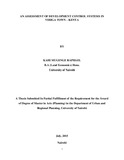| dc.description.abstract | Development control is aimed at encouraging the use of land resource in a way that promotes
prudent management of the natural environment. It calls for regulatory actions to mitigate against
negative externalities from the use of land in rural, urban and pre-urban areas. These regulatory
actions should be based on clear assessment of the capacity needed to implement them. The
regulatory actions are referred to as development control measures. As noted FAO (1993), such
measures are crucial because, Land resources are limited and finite. If human populations
continue to increase at the present rate there will be twice as many people in the world in about
60 years. There is therefore an increasingly urgent need to match land types and land uses in the
most rational way possible, so as to maximize sustainable production and satisfy the diverse
needs of society while at the same time conserving fragile ecosystems and our genetic heritage.
Uncoordinated development, poor planning and management of land and its use is a major
challenge in urban areas. An efficient and effective development control system is a pre-requisite
to a vibrant land market that will trigger economic development.
Several factors were checked to determine the causes of ineffective land use planning and
development control. The achievements of the Local Physical Development Plan of Vihiga
Town were identified and evaluated. The challenges were examined with the intentions of
finding interventions to the constraints and proposal as to the way forward so as to achieve
effective local physical development planning and development control.
Literature from other researchers, existing laws and set policy guidelines was reviewed. This
formed the theoretical and conceptual framework of the study. Useful data was obtained through
observations, interviews, administration of questionnaires to the subjects which included
government officers, market committees, property owners and the general household. The data
collected was analyzed using SPSS, then sorted using descriptive statistics and presented using
descriptive tables, photographs, maps, charts and narratives.
It was established that the county government of Vihiga has no development control policy and
guidelines that guide approval of development applications. It has turned enforcement effort to
an act of revenue collection. There is generally weak institutional capacity to deal with
enforcement of development controls. Several challenges to development control were identified.
They included ineffective policy guiding development control, unsuitable methodology, delays
in approval of development applications, weak institutional capacity amongst agencies charged
with development control, political interference and lack of political will, weak legal machinery,
and inadequate awareness of development control activities and public participation. Amongst
the above challenges, political interference and lack of political will ranked highest. The study
ends with conclusion and recommendation based on the findings of the research work. It lays the
basis of further research which is suggested. | en_US |

